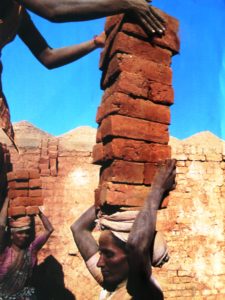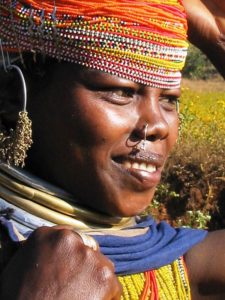BY RUNOKO RASHIDI*
Dedicated to the Memory of Dr. B.R. Ambedkar (1891-1956)
Since the first modern humans (Homo sapiens sapiens) were of African birth, the African presence globally can be demonstrated through the history of the Black populations that have inhabited the world within the span of recent humanity. Not only are African people the aboriginal people of the planet, however, there is abundant evidence to show that Black people created and sustained many of the world’s earliest and most-enduring civilizations. Such was the case in India.
Exceptionally valuable writings reflecting linkages between Africa and early India have existed for more than 2,000 years. Apollonius of Tyana, who is said to have visited India near the end of the first century, was convinced that “The Ethiopians are colonists sent from India, who follow their forefathers in matters of wisdom.” The literary work of the early Christian writer Eusebius preserves the tradition that, “In the reign of Amenophis III [the mighty Dynasty XVIII Ancient Egyptian king] a body of Ethiopians migrated from the country about the Indus, and settled in the valley of the Nile.” And still another document from ancient times, “The Itinerarium Alexandri,” says that “India, taken as a whole, beginning from the north and embracing what of it is subject to Persia, is a continuation of Egypt and the Ethiopians.” The commentary of Diodorus Siculus (circa 45 B.C.) reflects the same theme:
“From Ethiopia he (Osiris) passed through Arabia, bordering upon the Red Sea as far as to India, and the remotest inhabited coasts; he built likewise many cities in India, one of which he called Nysa, willing to have remembrance of that (Nysa) in Egypt where he was brought up.”
And then there is the story of the Ethiopian king, Ganges, conveyed by Samuel Purchas and cited by J.A. Rogers. The citation reads:
“But of all (the kings of Ethiopia) Ganges was most famous, who with his Ethiopian army passed into Asia and conquered all as far as the River Ganges to which he left that name, being before called Chliaros.”
The Aryans in India
The white tribes that invaded ancient Pakistan and India and disrupted Black civilization there are known as Aryans. The Aryans were not necessarily superior warriors to the Blacks, but they were aggressive, developed sophisticated military technologies and glorified military virtues. After hundreds of years of intense martial conflict between the Dravidians and Aryans, the Aryans succeeded in subjugating most of northern India. By about 800 B.C. these nomadic Aryan tribes had conquered Pakistan and all of northern India, naming their newly won territories after themselves, Aryavarta, or the Aryan Land.
Throughout the vanquished territories a rigid, caste-segmented social order was established with the masses of conquered Blacks (the Sudras) essentially reduced to slaves to the whites and imposed upon for service in any capacity required by their Aryan conquerors. This vicious new world order was cold-bloodedly racist, with the whites on top, the “mixed races” in the middle, and the overwhelming majority of Black people on the very bottom, and imposed upon for service in any capacity required to the higher castes. In fact, the Sanskrit term varna, denoting one’s societal status and used interchangeably with caste, literally means color or complexion and reflects a prevalent racial stratification and hierarchy.
Caste in India is the foundation of the religion known as Hinduism. Caste law in India, based originally on race and ethnicity, regulated all aspects of life, including marriage, diet, education, place of residence and occupation. This is not to deny that there were certain elements of the ancient Black aristocracy that managed to gain prominence in the dominant white social structure. The masses of conquered Blacks, however, were regarded by the whites as Untruth itself. The whites claimed to have emerged from the mouth of God; the Blacks, on the other hand, were said to have emerged from the feet of God. This was the ugly reality for the Black masses in conquered India.
The highest caste was the Brahmin (the Aryan elite) and identified with the color white; followed by the Kshatriyas (the military and administrative sector) identified with the color red; the Vaisyas (merchants and farmers) and identified with the color yellow; and, of course, the Sudras themselves, identified with the color black. Beneath even the Sudras were the outcastes or untouchables, composed of the unfortunate offspring of Brahmin-Sudra unions and long-established Black populations in India, which had retreated into the hinterlands to escape the Aryan advances, but ultimately coming under the Aryan sphere of influence.
For the maintenance of the new order a detailed religious and legal code was implemented, which regulated even the most minute aspects of daily life. In respect to the Sudras and outcastes, the code was quite simply draconian, with few if any ambiguities about it. Because of the critical nature of this subject — the study of early race and cultural relations in South Asia — several illustrative passages from “The Law of Manu” (Manu being a mythical Indian sage and lawgiver and supposedly a descendant of Brahman) are offered for critical examination:
“Twice-bom (Brahmins, Kshatriyas, Vaisyas) who, in their fony, wed wives of the low (Sudra) caste, soon degrade their families and their children to the state of Sudras.
He who weds a Sudra woman becomes an outcast, according to Saunaka on the birth of a son, and according to Bhrigu he who has (male) offspring from a (Sudra female, alone).
A Brahmana who takes a Sudra wife to his bed, will (after death) sink into hell …
Let him not anow a dead Brahmana to be carried out by a Sudra, while men of the same caste are at hand; for that burnt-offering, which is defiled by a Sudra’s touch, is detrimental to (the deceased’s passage to) heaven.
A Brahmana … may, at the king’s pleasure, interpret the law to him but never a Sudra.
A Kshatriya, having defamed a Brahmana, shall be fined one hundred (panas); a Vaisya one hundred and fifty or two hundred; a Sudra shall suffer corporal punishment.
A Brahmana shall be fined fifty (panas) for defaming a Kshatriya; in (the case of) a Vaisya the fine shall be twenty-five (panas); in (the case of) Sudra twelve.
A once-born man (a Sudra), who insults a twice-born man with gross invective, shall have his tongue cut out; for he is of low origin.
If he mentions the names and castes of the (twice-born) with contumely, an iron nail, ten fingers long, shall be thrust red-hot into his mouth.
If he arrogantly teaches Brahmanas their duty, the king shall cause hot oil to be poured into his mouth and into his ears.
A low-caste man who tries to place himself on the same seat with a man of high caste, shall be branded on his hip and be banished, or (the king) shall cause his buttock to be gashed.
If out of arrogance he spits (on a superior), the king shall cause both his lips to be cut off; if he urinates (on him), the penis; if he breaks wind (against him), the anus.”
For the Sudras and outcastes, as we have noted and followed with the evidence, “The Law of Manu” was brutal and vicious, and designed to keep them in their lowly caste position from generation to generation unto eternity. However, there was a way upward, for the Sudras at any rate, and Manu himself articulates the method: “[A Sudra who is] pure, the servant of his betters, gentle in speech, and free from pride, and always seeks a refuge with Brahmanas, attains [in his next life] a higher caste.”
As the very name implies, the life of the Indian outcaste was full of misery and impoverishment. Food and drink, if seen by them, were not to be taken. Generally they lived in settlements on the outskirts of villages and towns. In certain periods in Indian history outcastes, or untouchables, were not allowed to enter the adjoining Hindu community at night, in other periods, in daylight. Indeed, the outcaste’s very shadow was thought-polluting. Outcastes were required to attach a broom to their backs to erase any evidence of their presence. A cup was tied around their necks to capture any spittle that might escape their lips. The untouchable possessions consisted of dogs and donkeys. Their meals were consumed from broken dishes. Their clothing was taken from corpses. The principal functions of the outcastes included street sweeping, the removal of dead animals and human corpses, and the clean-up of cremation grounds; all of which was regarded as impure, even by the Sudras.
Dravidian Kingdoms
From at least the third century, three major Dravidian kingdoms existed in South India — the kingdoms of Pandya, Chera and Chola. Pandya was the southernmost Dravidian kingdom. The major city of Pandya was Madurai, the location of the famous chapel of the Tamil Sangam (Academy). The Sangam, of which there were three, was initiated by a body of 48 exceptionally learned scholars who established standards over all literary productions. The Pandyan rulers received these intellectuals with lavish honors.
It is also important to note that in the kingdom of the Pandyas women seem to have enjoyed a high status. This is the exact opposite of the regions of India where the whites ruled. In these lands of Aryan domination it is said that a woman was never independent. “When she is a child she belongs to her father. As an adult when she marries she belongs to her husband. If she outlives her husband she belongs to her sons.” An early queen of the Pandyas, on the other hand, is credited with controlling an army of 500 war elephants, 4,000 cavalry and 13,000 infantry.
To the northwest of Pandya was the kingdom of Chera (present-day Kerala). Northwest of Pandya lay the kingdom of Chola, said to be the place where Saint Thomas the Apostle was buried. The Venetian traveler Marco Polo, who visited India in 1288 and again 1293, referred to Chola as “the best province and the most refined in all India.” Polo further exclaimed that:
“The darkest man is here the most highly esteemed and considered better than the others who are not so dark. Let me add that in very truth these people portray and depict their gods and their idols black and their devils white as snow. For they say that God and all the saints are black and the devils are all white. That is why they portray them as I have described.”
The Dravidians were an unusually advanced seafaring people, with the Cholas, in particular, distinguishing themselves amongst the dominant maritime powers of their era. Through its ports, the great kings of Chola traded with Ethiopia and Somalia, Iran and Arabia, Cambodia and China, Sumatra and Sri Lanka, exporting spices and camphor, ebony and ivory, quality textiles and precious jewels.
The kingdoms of the Dravidians produced great poets and writers. Cuntarar, also known as Sundaramurti, was, during the eighth century, the most prominent of the highly esteemed Nayanars poets of Tamil Nadu, India. The Periya Puranam, which collects the legends of the Nayanars, starts and ends with him. The hymns of seventh volume of the Tirumurai, the 12-volume compendium of the poetry of Tamil Shaiva Siddhanta, were composed by him. Cuntarar is unique among the Nayanars in that both of his parents are also recognized as Nayanars. The ruler of the local kingdom (Thirumunaipadi-Nadu) adopted him. Tamil legend states that Cuntarar became tired of life and was taken up to heaven by a white elephant.
Kulashekhara Varma (800-820 A.D.), was a Tamil king who founded the second Chera Empire of South India. As king, Kulashekhara Varman united the present-day state of Kerala into a homogenous political entity that became a powerful force in South India for three centuries from 800 to 1102. He ruled from the capital city of Mahodayapuram (present Kodungallur). He is also one of the famous Hindu saints of the Vaishnavite movement of South India who composed one of the most celebrated devotional works of the Tamil Bhakti cult. It is believed that he renounced the crown to become a holy man and ascetic.
To the northeast of Pandya lay the Kingdom of Chola, said to house the resting place of Saint Thomas the Apostle. Aditya I was a monarch of the South Indian Kingdom of Chola, and led Chola to victory against the rival kingdoms of Pandya and Pallava. Around 885 A.D., in a mighty battle, the armies of Pandya and Nripatunga Pallava were routed by Aparajita Pallava and Aditya I of Chola. The epic Tamil novel “Ponniyin Selvan” describes this as a battle that changed the course of South India history. Aditya I also built a number of temples for Shiva along the banks of the Kaveri River. Aditya I had a long and victorious reign during which he laid the foundations for the future greatness of the Chola Empire.
The Dravidian kingdoms of South India were well known in the West, having sent several embassies to Rome in particular, in spite of the great distance involved. During the height of their commercial relations, South India was said to extract 100 million sesterces annually from the Roman economy.
Dalits: The Black Untouchables of India
The greatest victims of Hinduism have been those outside the caste system — the outcastes — better known as untouchables. Indeed, probably the most substantial percentage of all the Black people of Asia can be identified among India’s 200 million Untouchables. These people are the long-suffering descendants of Aryan-Sudra unions and native Black populations who retreated into the hinterlands of India in their efforts to escape the advancing Aryan sphere of influence to which they ultimately succumbed. India’s Untouchables number more than the combined populations of England, France, Belgium and Spain.
The existence of Untouchability has been justified within the context of Hindu religious thought as the ultimate and logical extensions of Karma and rebirth. Hindus believe that persons are born Untouchables because of the accumulation of sins in previous lives. Hindu texts describe these people as foul and loathsome, and any physical contact with them was regarded as polluting.
The basis status of India’s Untouchables has changed little since ancient times, and it has recently been observed that caste Hindus do not allow Untouchables to wear shoes, ride bicycles, use umbrellas or hold their heads up while walking in the street.
Untouchables in urban India are crowded together in squalid slums, while in rural India, where the vast majority of Untouchables live, they are exploited as landless agricultural laborers and ruled by terror and intimidation. Even when charges are formally filed, justice for Untouchables is rarely dispensed.
Frequently the Untouchables are called Outcastes. Indian nationalist leader and devout Hindu Mohandas K. Gandhi called them Harijans, meaning children of God. The official name given them in India’s constitution (1951) is Scheduled Castes. Dalit, meaning crushed and broken, is a name that has come into prominence only within the last four decades. Dalit reflects a radically different response to oppression.
The Dalit are demonstrating a rapidly expanding awareness of their African ancestry and their relationship to the struggle of Black people throughout the world. They seem particularly enamored of African-Americans. The Black Panther Party, in particular, is revered. In April 1972, for example, the Dalit Panther Party was formed in Bombay, India. This organization takes its pride and inspiration directly from the Black Panther Party of the United States. This is a highly important development due to the fact that the Untouchables have historically been so systematically terrorized that many of them, even today, live in a perpetual state of extreme fear of their upper caste oppressors. This is especially evident in the villages. The formation of the Dalit Panthers and the corresponding philosophy that accompanies it signals a fundamental change in the annals of resistance, and Dalit Panther organizations have subsequently spread to other parts of India. In August 1972, the Dalit Panthers announced that the 25th anniversary of Indian independence would be celebrated as a day of mourning. In 1981, in Bangalore, India Dravidian journalist V.T. Rajshekar published the first issue of Dalit Voice — the major English journal of the Black Untouchables. In a 1988 publication titled the “African Presence in Early Asia,” Rajshekar stated that:
“The African-Americans also must know that their liberation struggle cannot be complete as long as their own blood-brothers and sisters living in far off Asia are suffering. It is true that African-Americans are also suffering, but our people here today are where African-Americans were two hundred years ago. African-American leaders can give our struggle tremendous support by bringing forth knowledge of the existence of such a huge chunk of Asian Blacks to the notice of both the American Black masses and the Black masses who dwell within the African continent itself.”
*Runoko Rashidi is an African-American historian based in Los Angeles and is the author or editor of 18 books about travel and African and African-American history. His latest work is “African Star over Asia: The Black Presence in the East,” published by Books of Africa in 2012. He can be reached at [email protected]






